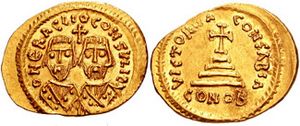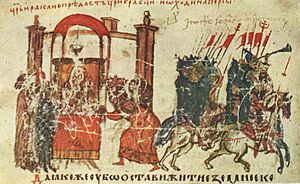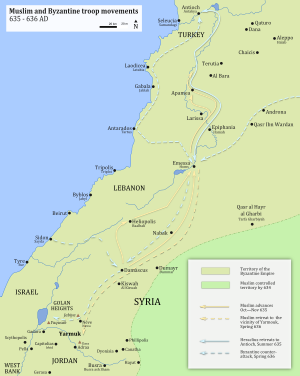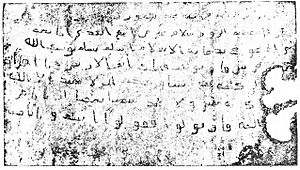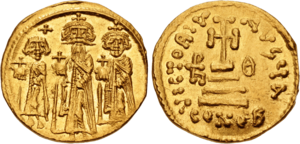Heraclius facts for kids
Quick facts for kids Heraclius |
|
|---|---|
| Emperor of the Romans | |

Solidus of Emperor Heraclius (aged 35–38). Constantinople mint. Struck 610–613.
|
|
| Byzantine emperor | |
| Reign | 5 October 610 – 11 February 641 |
| Predecessor | Phocas |
| Successor | Constantine III Heraclonas |
| Co-emperors | Constantine III (613–641) Heraclonas (638–641) |
| Born | c. 575 Cappadocia, Byzantine Empire |
| Died | 11 February 641 (aged 65) Constantinople, Byzantine Empire |
| Spouse | Eudokia Martina |
| Issue | Constantine III Heraclonas John Athalarichos (illegitimate) Martinus David Tiberius Theodosius Augustina Anastasia |
| Dynasty | Heraclian |
| Father | Heraclius the Elder |
| Mother | Epiphania |
| Religion | Chalcedonian Christianity |
Heraclius (Greek: Ἡράκλειος, translit. Hērákleios; around 575 – 11 February 641) was the Eastern Roman emperor from 610 to 641. He became emperor after leading a revolt with his father, Heraclius the Elder. His father was the governor of Africa. They rebelled against the unpopular ruler Phocas in 608.
Heraclius's time as emperor was full of military battles. When he took power, the empire was under attack from many sides. Heraclius immediately took charge of the Byzantine–Sasanian War of 602–628. At first, the Byzantine army lost battles. The Persian army even reached the Bosphorus strait. But Constantinople was safe behind its strong walls and with a powerful navy. Heraclius managed to avoid a complete defeat. Soon after, he made changes to rebuild and strengthen the army. Heraclius pushed the Persians out of Asia Minor. He then went deep into their land. He defeated them in a big battle in 627, called the Battle of Nineveh. The Persian king Khosrow II was removed from power and killed by his own son, Kavad II. Kavad II quickly asked for peace. He agreed to leave all the lands his father had taken. This brought peace back to the two empires, which had been fighting for a long time.
However, Heraclius soon lost many of these lands to the Muslims. These new forces came from the Arabian Peninsula. They quickly conquered the Sasanian Empire. In 636, the Muslims marched into Roman Syria. They defeated Heraclius's brother Theodore. In a short time, the Arabs took over Mesopotamia, Armenia, and Egypt. Heraclius made more changes to his empire. These changes helped his future rulers fight the Arabs and prevent total destruction.
Heraclius also made friends with the Croats and Serbs in the Balkans. He tried to fix a disagreement in the Christian church. This disagreement was about the Monophysites. He suggested a new idea called Monothelitism to bring everyone together. The Church of the East (also called Nestorian) was part of these talks. But in the end, no one agreed to this plan for unity.
Contents
Heraclius's Background and Family
Heraclius was the oldest son of Heraclius the Elder and Epiphania. His father, Heraclius the Elder, is thought to have been from Armenia. His mother, Epiphania, was likely from Cappadocia. Some historians believe Heraclius probably spoke both Armenian and Greek from a young age.
His father was an important general for Emperor Maurice. He fought in a war against Bahram Chobin, a ruler in the Sasanian Empire, around 590. After the war, Maurice made Heraclius the Elder the Exarch (governor) of Africa.
How Heraclius Became Emperor
Revolt Against Phocas
In 608, Heraclius the Elder stopped supporting Emperor Phocas. Phocas had taken the throne from Maurice six years earlier. The rebels made coins showing both Heraclius and his father. These coins showed them as important officials, but they did not yet claim to be emperors. Heraclius's younger cousin, Nicetas, led an army by land into Egypt. By 609, he had beaten Phocas's general and taken control of Egypt. Meanwhile, the younger Heraclius sailed east with another army. He went through Sicily and Cyprus.
As he got close to Constantinople, he talked with important leaders. He planned to attack and overthrow the city's powerful people. When he reached the capital, the Excubitors, who were the emperor's special guards, joined Heraclius. Their leader was Phocas's son-in-law. Heraclius entered the city without much fighting. When Heraclius captured Phocas, he asked him, "Is this how you have ruled, you terrible man?" Phocas replied, "And will you rule better?" This made Heraclius so angry that he killed Phocas right away.
On October 5, 610, Heraclius was crowned emperor. The ceremony took place in the Chapel of St. Stephen in the Great Palace. He then married Fabia, who changed her name to Eudokia. She died in 612. In 613, he married his niece Martina. Martina became very powerful and caused political problems during the rule of Heraclius's two sons. Many people in Constantinople disliked Martina. But Heraclius took her with him on his military trips. He also refused requests from the church leader, Patriarch Sergius, to end their marriage.
Wars with the Persian Empire
Early Persian Victories
Emperor Maurice and his family were killed by Phocas in November 602. This happened after a rebellion during Maurice's wars in the Balkans. Khosrow II of the Sasanian Empire had been helped by Maurice to get his throne back. They were allies until Maurice died. After Maurice's death, Khosrow used this chance to attack the Byzantine Empire. He wanted to take back Mesopotamia. Khosrow had a man at his court who claimed to be Maurice's son. Khosrow demanded that the Byzantines accept this man as their new emperor.
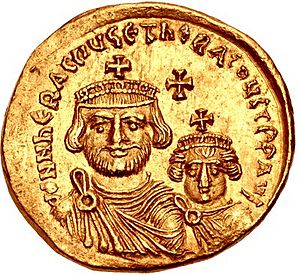
At first, the war went well for the Persians. This was partly because Phocas was a harsh ruler. Also, there was a crisis about who would be the next emperor. General Heraclius sent his nephew Nicetas to attack Egypt. This helped Heraclius's son, the younger Heraclius, claim the throne in 610. Phocas was not liked by the people. He was often called a "tyrant" (meaning an unfair ruler who took power illegally). Heraclius finally removed Phocas from power. Heraclius sailed to Constantinople from Carthage with a holy image on the front of his ship.
By this time, the Persians had taken over Mesopotamia and the Caucasus region. In 611, they invaded Syria and entered Anatolia. Heraclius led a major counter-attack two years later. But his army was badly beaten outside Antioch by Persian generals. The Roman army was falling apart. The Persians destroyed parts of Asia Minor. They even captured Chalcedon, which was right across from Constantinople on the Bosporus.
Over the next ten years, the Persians conquered Palestine and Egypt. By mid-621, they controlled all of Egypt. They also damaged Anatolia. At the same time, the Avars and Slavs took advantage of the situation. They invaded the Balkans. The empire was almost completely destroyed. In 613, the Persian army took Damascus. They were helped by Jewish people. In 614, they captured Jerusalem. They damaged the Church of the Holy Sepulchre and took the True Cross. After that, they captured Egypt in 617 or 618.
When the Persians reached Chalcedon in 615, Heraclius almost gave up. He was ready to let the Byzantine Empire become a state controlled by Persia. He even allowed Khosrow II to choose the emperor. In a letter, Heraclius said the Persian empire was stronger. He called himself Khosrow II's "obedient son." He also called Khosrow II the "supreme emperor." But Khosrow II still refused the peace offer. He even arrested Heraclius's messengers.
With the Persians right outside Constantinople, Heraclius thought about leaving the city. He considered moving the capital to Carthage. But the powerful church leader, Patriarch Sergius, convinced him to stay. Safe behind Constantinople's walls, Heraclius asked for peace. He offered to pay a yearly tribute. This included a thousand talents of gold, a thousand talents of silver, a thousand silk robes, a thousand horses, and a thousand virgins for the Persian King. This peace allowed him to rebuild his army. He cut spending on non-military things. He also reduced the value of money. With the help of Patriarch Sergius, he even melted down church treasures. This raised the money needed to keep fighting the war.
Byzantine Comeback and Victory
On April 4, 622, Heraclius left Constantinople. He left Sergius and general Bonus in charge of the city and his son. He gathered his forces in Asia Minor. He probably did this in Bithynia. After he made his soldiers feel hopeful again, he started a new attack. This attack felt like a holy war. A special image of Christ was carried as a battle flag.
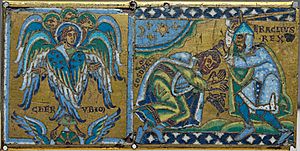
The Roman army went to Armenia. They defeated an army led by an Arab chief who was allied with Persia. Then they won a victory over the Persians. Heraclius continued fighting for several years. On March 25, 624, he left Constantinople again. He took his wife, Martina, and his two children with him. After celebrating Easter on April 15, he fought in the Caucasus. He won many victories in Armenia against Khosrow and his generals. In the same year, the Visigoths took back Cartagena. This was the capital of a small Byzantine province in the west. In 626, the Avars and Slavs, helped by a Persian army, attacked Constantinople. But the attack failed. People believed the victory was due to holy images of the Virgin Mary. These images were carried around the city walls by Sergius. Meanwhile, a second Persian army was badly defeated by Heraclius's brother Theodore.
The Persian war effort was falling apart. Heraclius was able to get the Gokturks to help him. Their leader, Ziebel, invaded Persian Transcaucasia. Heraclius used the disagreements within the Persian Empire. He kept a Persian general named Shahrbaraz from fighting him. He convinced Shahrbaraz that Khosrow was jealous and wanted him killed. In late 627, Heraclius launched a winter attack into Mesopotamia. Even though his Turkish allies left him, he defeated the Persians at the Battle of Nineveh. He continued south along the Tigris River. He looted Khosrow's large palace at Dastagird. He was only stopped from attacking Ctesiphon because the bridges over a canal were destroyed. Khosrow was disgraced by these defeats. He was overthrown and killed in a revolt led by his son Kavad II. Kavad II immediately asked for peace. He agreed to leave all the lands his father had taken. In 629, Heraclius brought the True Cross back to Jerusalem in a grand ceremony.
After his victory, Heraclius took the old Persian title "King of Kings." Later, starting in 629, he called himself Basileus. This is the Greek word for "sovereign" or "ruler." Byzantine emperors used this title for the next 800 years. Some scholars think Heraclius chose this title because of his Armenian background.
Heraclius's defeat of the Persians ended a war that had lasted on and off for almost 400 years. It also caused problems in the Persian Empire. Kavad II died only months after becoming king. This led to many years of fighting and civil war in Persia. Several rulers took the throne within months of each other. These included Ardashir III, Heraclius's ally Shahrbaraz, and Khosrow's daughters Boran and Azarmidokht. Stability only returned when Yazdgerd III, a grandson of Khosrow II, became king in 632. But by then, the Sasanian Empire was very disorganized. It had been weakened by years of war and civil unrest over who would rule.
The war had been very damaging. It left the Byzantines in a much weaker state. Within a few years, both empires were attacked by the Arabs. This eventually led to the Arab conquest of Persia and the end of the Sasanian dynasty in 651.
Wars with the Arabs
By 630, the Arabs had united all the tribes in the Hijaz region. Before this, they were too divided to be a serious military threat to the Byzantines or Persians. They became one of the most powerful states in the area. The first fight between the Byzantines and the Arabs was the Battle of Mu'tah in September 629. A small Arab force attacked the province of Arabia. They did this because an Arab messenger had been killed by the Roman governor. But the Arabs were pushed back. Since the Byzantines won this battle, they didn't think they needed to change their army. The Roman army was not used to fighting large Arab armies. The Arab forces also had no experience fighting the Romans. Even the Strategicon of Maurice, a famous book about war, doesn't talk much about fighting Arabs. The strong religious belief of the Arab army, which grew with the rise of Islam, helped them win their battles against the Romans.
The next year, the Arabs attacked the Arabah area south of Lake Tiberias. They took al-Karak. Other raids went into the Negev desert, reaching as far as Gaza. The Battle of Yarmouk in 636 was a huge defeat for the larger Byzantine army. Within three years, the Levant region was lost again. Heraclius died from an illness on February 11, 641. Most of Egypt had also fallen to the Arabs by that time.
Heraclius's Achievements
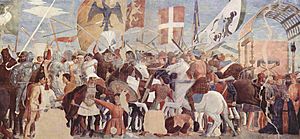
When we look back at Heraclius's time as emperor, scholars say he achieved many great things. He made the empire larger. His changes to the government and military were very successful. His attempts to bring religious groups together didn't work. But he did succeed in bringing back the True Cross, a very holy Christian item, to Jerusalem.
Government and Military Reforms
Even though the lands he won from the Persians were later lost to the Muslims, Heraclius is still considered one of the greatest Roman emperors. His changes to the government reduced the corruption that had started during Phocas's rule. He also successfully reorganized the military. In the end, the new Imperial army stopped the Muslims in Asia Minor. It also held onto Carthage for another 60 years. This saved a central part of the empire, from which its strength could be rebuilt.
Bringing back the eastern parts of the Roman Empire from the Persians brought up the problem of religious unity again. This was about understanding the true nature of Christ. Most people in these areas were Monophysites. They did not accept the decisions of the Council of Chalcedon. Heraclius tried to promote a compromise idea called Monothelitism. But this idea was rejected as heretical (wrong belief) by both sides. Because of this, some later religious writers saw Heraclius as a heretic and a bad ruler. After the Monophysite areas were lost to the Muslims, Monotheletism was no longer needed. It was eventually given up.
The Croats and Serbs in Byzantine Dalmatia started friendly relations with Heraclius. The Serbs, who lived in Macedonia for a short time, became allies. They were baptized as Christians at Heraclius's request (before 626). At his request, Pope John IV (640–642) sent Christian teachers to Duke Porga and his Croats. They practiced Slavic paganism (old beliefs). Heraclius also created the job of sakellarios, who managed the empire's money.
Until the 20th century, Heraclius was thought to have created the Thematic system. This was a way of organizing the empire into military districts. But modern studies now suggest it was created later, around the 660s, under Constans II.
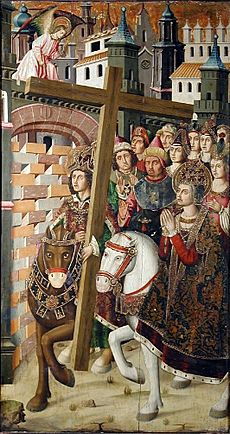
Bringing Back the True Cross
Heraclius was remembered well by the Western church for bringing back the True Cross from the Persians. As Heraclius got close to the Persian capital during the last part of the war, Khosrow ran away from his palace near Baghdad. He did not fight back. Meanwhile, some important Persian leaders freed Khosrow's oldest son Kavad II. Kavad had been put in prison by his father. They made him king on the night of February 23–24, 628. However, Kavad was very sick and worried about his young son. So, as a sign of goodwill, he sent the True Cross with a negotiator in 628.
After traveling around the empire, Heraclius returned the cross to Jerusalem on March 21, 629 or 630. For Christians in Western Medieval Europe, Heraclius was seen as the "first crusader." Images of the emperor appeared in churches. The story was included in the Golden Legend, a famous book from the 13th century about saints. He is sometimes shown in art, like in the paintings by Piero della Francesca in Arezzo. These paintings show scenes of Heraclius and Constantine I's mother Saint Helena. Saint Helena is traditionally believed to have found the cross. The scene often shown is Heraclius carrying the cross. According to the Golden Legend, he insisted on doing this as he entered Jerusalem. His church leaders advised against it. At first, when he was on horseback, the cross was too heavy. But after he got off his horse and took off his crown, it became magically light. The city gate, which was closed, opened by itself.
Some scholars disagree with this story. Professor Constantin Zuckerman even suggests that the True Cross was actually lost. He thinks the wood brought to Jerusalem by Heraclius in 629 was a fake. He believes this trick was planned to help both Heraclius and his former enemy, the Persian general Shahrbaraz.
Islamic View of Heraclius
In early Islamic and Arab histories, Heraclius is a very popular Roman emperor. He is talked about a lot. Because he was the Roman emperor when Islam began, he is remembered in Arabic literature. This includes Islamic hadith (sayings of the Prophet) and sira (biographies of the Prophet).
The Swahili Utendi wa Tambuka, a long poem written in 1728, tells about the wars between Muslims and Byzantines from the Muslim point of view. It is also known as Kyuo kya Hereḳali ("The Book of Heraclius"). In this poem, Heraclius refuses the Prophet's request to stop believing in Christianity. Because of this, he is defeated by the Muslim forces.
In Muslim tradition, Heraclius is seen as a fair ruler who was very religious. He had direct contact with the new Islamic forces. A scholar from the 14th century, Ibn Kathir, even said that "Heraclius was one of the wisest men and among the most determined, clever, deep, and strong-minded kings. He ruled the Romans with great leadership and glory." Historians like Nadia Maria El-Cheikh and Lawrence Conrad note that Islamic histories even claim Heraclius recognized Islam as the true faith. They also say he recognized Muhammad as its prophet, comparing Islam to Christianity.
Islamic historians often mention a letter they claim Heraclius wrote to Muhammad. It says: "I have received your letter with your ambassador. I confirm that you are the messenger of God found in our New Testament. Jesus, son of Mary, announced you." According to Muslim sources, Heraclius tried to convert the empire's ruling class. But they strongly resisted. So, he changed his mind and claimed he was just testing their faith in Christianity. El-Cheikh notes that these stories about Heraclius don't add much to our historical knowledge of him. Instead, they are an important part of "Islamic kerygma" (religious message). They try to prove Muhammad's status as a prophet.
Most Western historians believe such traditions are biased and not very accurate. They argue that any messengers sent by Muhammad to Heraclius would not have met the emperor or been recognized. According to historian Kaegi, there is no proof outside of Islamic sources that Heraclius ever heard of Islam. It is possible that he and his advisors thought the Muslims were just a special group of Jews.
Heraclius's Family Life
Heraclius was married two times. First, he married Fabia Eudokia, who was the daughter of Rogatus. Then, he married his niece Martina. He had two children with Fabia: Eudoxia Epiphania and Emperor Constantine III. He had at least nine children with Martina. Most of them were often sick. At least two of Martina's children had disabilities. This was seen as a punishment because their marriage was considered illegal. For example, Fabius (Flavius) had a paralyzed neck, and Theodosios could not hear or speak. Theodosios married Nike, who was the daughter of the Persian general Shahrbaraz, or the daughter of Niketas, Heraclius's cousin.
Two of Heraclius's children became emperor. These were Heraclius Constantine (Constantine III), his son with Eudokia, and Martina's son Heraclius (Heraclonas). Constantine was crowned co-emperor on January 22, 613, when he was 8 months old. Heraclonas was made a junior emperor on January 1, 632, at age 6. He was later crowned full emperor on July 4, 638. They ruled together for a few months in 641. But they were eventually replaced by Constans II, Constantine III's son, by the end of that year.
Heraclius also had at least one son born outside of marriage, John Athalarichos. This son planned against Heraclius with his cousin and an Armenian noble. When Heraclius found out, he sent Athalarichos away to an island. His cousin was also sent away.
During Heraclius's last years, it was clear there was a power struggle. Heraclius Constantine and Martina were fighting. Martina wanted her son Heraclonas to become emperor. When Heraclius died, he stated in his will that both Heraclius Constantine and Heraclonas should rule together. Martina was to be empress.
See also
 In Spanish: Heraclio para niños
In Spanish: Heraclio para niños
- Cathedral of Mren
- Flavia gens
- Non-Muslim interactants with Muslims during Muhammad's era
- Revolt against Heraclius


